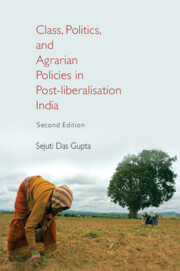Book contents
- Frontmatter
- Dedication
- Contents
- List of Tables and Figures
- List of Abbreviations
- Acknowledgements
- Maps
- 1 Introduction
- 2 Policy-making, Class Factor, and Political Settlement: Setting the Theoretical Framework
- 3 Privatising the Inputs of Production: A Case of Careful Choice of Beneficiaries and Losers
- 4 Chhattisgarh: New State, New Opportunities for Old Class Domination
- 5 Gujarat: Strong State-directed Capitalism across Sectors
- 6 Karnataka: State Patronage, Market Opportunism, and Urban–Rural Closing Gap
- 7 State in Action, Political Settlement, and the Agrarian Flux
- Bibliography
- Index
5 - Gujarat: Strong State-directed Capitalism across Sectors
Published online by Cambridge University Press: 30 April 2024
- Frontmatter
- Dedication
- Contents
- List of Tables and Figures
- List of Abbreviations
- Acknowledgements
- Maps
- 1 Introduction
- 2 Policy-making, Class Factor, and Political Settlement: Setting the Theoretical Framework
- 3 Privatising the Inputs of Production: A Case of Careful Choice of Beneficiaries and Losers
- 4 Chhattisgarh: New State, New Opportunities for Old Class Domination
- 5 Gujarat: Strong State-directed Capitalism across Sectors
- 6 Karnataka: State Patronage, Market Opportunism, and Urban–Rural Closing Gap
- 7 State in Action, Political Settlement, and the Agrarian Flux
- Bibliography
- Index
Summary
This chapter addresses three primary concerns. First, whether political settlement in Gujarat has undergone a change since liberalisation. Second, the impact of ‘class’ interest on state apparatus with respect to agricultural policies and, because of such policies, if the existing proprietary classes have transformed themselves, remained unaffected, or have been replaced by new classes. Third, given that the state has been welcoming market forces, particularly under Chief Minister Modi, whether the market's free play has curbed the state's role in agriculture. These questions have been addressed by assessing various aspects of Gujarat's agrarian policy after 2000, in addition to land acquisition policies. Simultaneously, an analysis of what these policies entail for different classes of farmers is developed alongside the other two proprietary classes – the capitalist and the petty bourgeoisie. This analysis is, thus, undertaken from two angles – classes’ influence on the state and the state's role in forming, altering, and consolidating classes. It is based on field research in Gujarat, conducted between October 2011 and January 2012.
The first section of the chapter offers a brief history of the state and outlines the changes in its economy in the past two decades. This is followed by sections presenting the fieldwork findings, in combination with a review of secondary literature. These sections first elaborate the main tenets of agricultural policy and the key factors behind the agricultural success of Gujarat, and then evaluate through a politico-economic lens, differential impact across classes and their fractions that have contributed to the agrarian success in Gujarat, particularly after 2000.
Brief overview
Geographical divisions
The present state of Gujarat historically constituted of two parts: Saurashtra and mainland Gujarat. During the colonial period, Saurashtra was a feudatory state and was constituted of 112 principalities, while the mainland was under the British rule. Baroda was an exception; it was situated in Gujarat but was ruled by an enlightened royalty reputed for its benevolence towards its subjects, contributing to the pursuit of education and arts among its population (Bakhle, 2005). Baroda merged with Gujarat in 1949. In 1960, the regional state of Bombay was divided into two states, Maharashtra and Gujarat. Thus, Gujarat gained independent statehood.
- Type
- Chapter
- Information
- Publisher: Cambridge University PressPrint publication year: 2024



